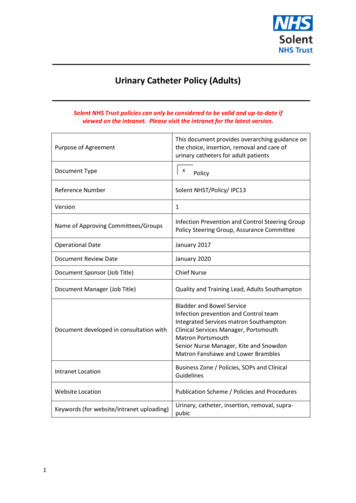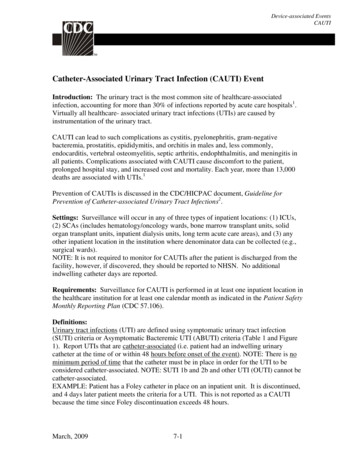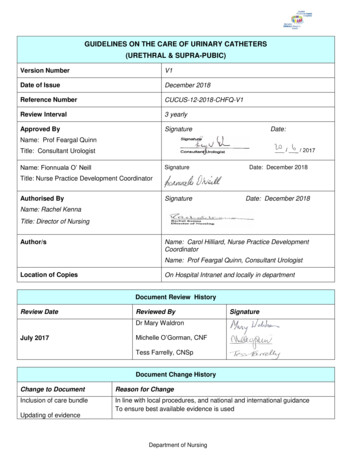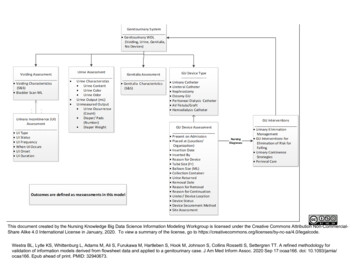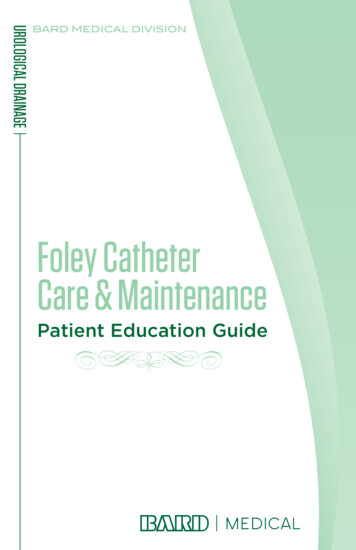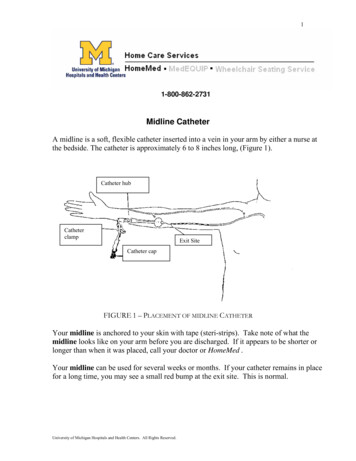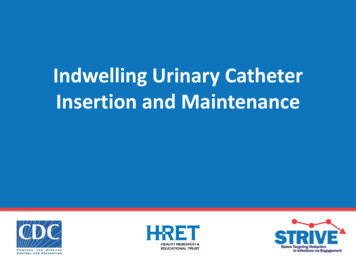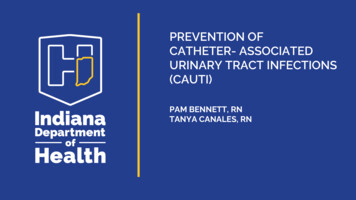
Transcription
PREVENTION OFCATHETER- ASSOCIATEDURINARY TRACT INFECTIONS(CAUTI)PAM BENNETT, RNTANYA CANALES, RN
OUR MISSION:To promote, protect, and improvethe health and safety of all Hoosiers.OUR VISION:Every Hoosier reaches optimal healthregardless of where they live, learn,work, or play.
What is a CAUTI?According to the CDC, a catheter-associatedurinary tract infection (CAUTI) can occurwhen germs and/or bacteria enter theurinary tract, involving any of the organs orstructures of the urinary tract, through theurinary catheter and cause an infection.(Including the kidneys, ureters, bladder,and/or urethra).
Why are CAUTI’s bad?There is strong correlation with CAUTI’s and an increased risk of morbidity,mortality, healthcare costs, and increased hospitalization. According to the National Healthcare Safety Network (NHSN), UTIs arethe most common type of healthcare-associated infection (HAI)reported - approximately 75% are associated with a urinary catheter. CAUTI is a potentially life-threatening HAI for LTC residents: 1.6 million to 3.8 million infections annually 388,000 deaths annually HAI’s in LTC facilities can be costly: 38 million to 137 million annually for antimicrobial therapy 673 million to 2 billion due to hospitalizations annually4
Best practices for indwelling catheters Place only when necessary and remove as quickly as possibleCatheters should only be inserted by a trained person using aseptic techniqueClean skin around meatus prior to insertion and routinely18 Fr or larger can increase erosion of bladder neck, so choose the smallest sizeappropriate for resident30 ml balloons are NOT recommendedConsider other methods to drain urine: external catheters, intermittent urethralcatheterization, suprapubic cathetersChanging indwelling catheters or drainage bags at routine, fixed intervals is nolonger recommendedChange catheters and drainage bags based on clinical indications such asinfection, obstruction, or when the closed system is compromised5
Appropriate indications for indwellingcatheter in LTC Acute urinary retention or bladder outletobstructionProtection of surgical sites or Stage 3 or 4 sacral orperineal wounds in incontinent patientsTo improve comfort for end-of-life care, if neededInappropriatecatheter uses: Substitute for nursingcare of the residentwith incontinence Immobile or obeseresident Resident or familyrequest6
Proper urinary catheter insertionPerform hand hygienePerform peri-careRe-perform hand hygieneMaintain strict aseptic techniqueInsert catheter to appropriate length and checkurine flow before balloon inflationo Inflate balloon correctly (5-10 cc)o Secure catheter tubing to leg with securementdeviceo Re-perform hand hygiene upon completionoooooReview the orderand verify catheteris clinicallyindicatedGather yourinsertion kit andother suppliesUse the buddysystem - get asecond pair ofhands to help7
Urinary catheter maintenanceo Maintain unobstructed urine flow: no kinks, twists, orloops in the tubingo Keep the collection bag below the level of thebladder at all times without ever resting bag on theflooro Maintain a closed drainage system at all timeso Empty bag regularly and keep bag under ¾ full at alltimeso Use individual, labeled collection container for eachresidentoDo not let drainage spigot touch the container (or floor)8
Urinary catheter maintenanceo Attach catheter tubing to leg withsecurement deviceo Perform hand hygiene prior to and aftercatheter contacto Perform daily perineal care with soapand water and when soiledo Review necessity of catheter regularlyand remove promptly when residentdoes not meet approved indications9
Long-term care facilitiesReview and update facility policies andprocedures and ensure they include: That routine changing of indwelling catheteris no longer supported in Long-term care Only change catheter prior to collection ofUrinalysis and Culture and prior to initiatingantimicrobial therapy Use aseptic technique when disconnecting/reconnecting a catheter bag to a leg bag. Cleanse connection tubing with an alcohol swab.Use a sterile cap to maintain sterility of thesystem being disconnected. Avoid reflux (refer to bundles)10
Symptoms of a Urinary Tract InfectionA CAUTI has similar symptoms to a typical urinary tractinfection (UTI) which include: cloudy urineblood in the urinestrong urine odorurine leakage around your catheterpressure, pain, or discomfort in your lower back or stomachchillsfeverunexplained fatiguevomiting11
If you suspect a CAUTIDiscuss with provider if a urinalysis andculture and sensitivity is appropriate. If so, then attain urine specimen prior toantibiotic therapy.Remember: Do not send a urinalysis orculture in asymptomatic residents. How to perform a urine culture:Specimen Collection: Urine from aFoley Catheter – YouTube**Follow up on culture resultsfor proper antibiotic use.12
Antibiotic stewardship Be involved Advocate for your residents Ensure accountabilityIDOH LTC Antibiotic Stewardship ageAntibioticStewardshipToolkit.pdfAHRQ educational bundles:Part I: PowerPoint slide set (PowerPoint)Part II: PowerPoint slide set (PowerPoint)13
Additional resources:AHRQ educational videos and PowerPoints:Catheter insertion and maintenanceReducing CAUTI in Long-Term Care Facilities: https://www.youtube.com/watch?v Ex7QLaa3XF4Equipment and Environment - Reducing CAUTI and other HAIs in Long-Term Care Facilities: Equipment and Environment--Reducing CAUTI and Other HAIs in Long-Term Care Facilities - YouTubeUrine culturing and antibiotic stewardshipKnow when to order a urine culture: ures.pptx14
ChecklistsInsertion checklist:Appendix G. Indwelling Urinary Catheter Insertion Checklist Agencyfor Healthcare Research and Quality (ahrq.gov)Maintenance checklist:Appendix H. Indwelling Urinary Catheter Maintenance Checklist Agency for Healthcare Research and Quality (ahrq.gov)15
Remember C.A.U.T.I. to prevent CAUTIAgency for Healthcare Research and Quality (2017). AHRQ Safety Program for Long-Term Care: Preventing CAUTI and Other HAIs. p.76. Retrievedfrom ces/tools/cauti-ltc/modules/final-report.pdf16
References: Agency for Healthcare Research and Quality (2017). AHRQ Safety Program for Long-Term Care: Preventing CAUTI and OtherHAIs. Retrieved from es/tools/cauti-ltc/modules/final-report.pdf Agency for Healthcare Research and Quality (2017) Appendix G. Indwelling Urinary Catheter Insertion Checklist. Retrieved list.html Agency for Healthcare Research and Quality (2017). Appendix H. Indwelling Urinary Catheter Maintenance Checklist. Retrievedfrom st.html Agency for Healthcare Research and Quality (2019). Educational Bundles. Retrieved tc/education-bundles.html Agency for Healthcare Research and Quality (2018). Prevent Catheter-Associated Urinary Tract Infection. Retrieved tc/prevent.html Center for Disease Control and Prevention (2010). Frequently Asked Questions about Catheter-associated Urinary TractInfections. Retrieved from https://www.cdc.gov/hai/ca uti/cauti faqs.html Hanchett, M. (2012). Preventing CAUTI: A patient-centered approach. Prevention, 43, 42-50.17
Questions?CONTACT:Pam Bennett: PBennett@isdh.IN.govTanya Canales: TCanales@isdh.IN.gov
Proper urinary catheter insertion 7 Review the order and verify catheter is clinically indicated Gather your insertion kit and other supplies Use the buddy system - get a second pair of hands to help o Perform hand hygiene o Perform peri-care o Re-perform hand hygiene o Maintain strict aseptic technique o Insert catheter to appropriate length .
